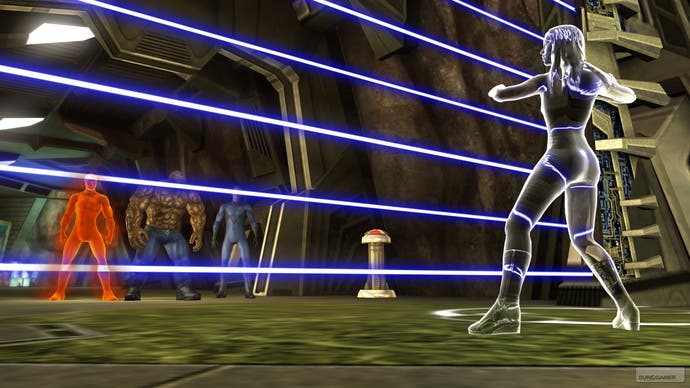Fantastic Four: Rise of the Silver Surfer
Silver by name, bronze by nature.
I call them Mysterio Moments, after that notorious mission in the Spider-Man 2 game where you had to scale the Statue of Liberty by swinging from hovering pods: moments where flaws that you'd previously tolerated suddenly combine and suck whatever fun remains out of the experience. And, when the game in question is based on blockbuster movies, that fun is usually already in short supply.
While the latest Fantastic Four game, which predictably takes the form of a four-way smash-'em-up, never quite scales the depths of teeth-grinding horror of the original Mysterio Moment (or indeed the wretched Spider-Man 3 - a game that seems to consist solely of Mysterio Moments) there are still several points where you find yourself wondering just how much playtesting it received.
The first and most annoying comes as the cosmic-powered quartet explore the space station of Soviet scientist Ivan Kragoff. In one of many examples of narrative padding to expand the action potential of the new movie, Kragoff's research may hold the key to tracking the Silver Surfer, a mysterious alien entity plaguing the planet with freak weather conditions and unnatural shininess. Kragoff, it should be pointed out, is also the Red Ghost, a classic Silver Age villain who commands an army of super-powered monkeys. This brings us the wonderful sight of The Thing fighting a rifle-wielding chimp by throwing turnips at it.

But that's beside the point. At one point in this level, Mr Fantastic has to go it alone when a door won't open fully. He squeezes through the gap and must stretch and bend his way past moving security beams, deactivating gun turrets and fighting monkeys, to reunite with his team-mates. All goes well, until you reach a dead end. An elevator takes you down and almost directly in front of you is a red laser fence that inflicts damage when touched. It's too high to jump or stretch over, and there are no obvious switches or junction boxes with which to deactivate it. After about twelve attempts to pass this obstacle, during which I played the same sections over and over, scouring every inch of the level for an answer, I realised what was needed.
On the floor above are several crates. Mr Fantastic can't pick them up - only The Thing has that ability - but by jiggling him near the end of a crate I was able to clumsily shunt a crate over the edge and use it to give me the necessary height to vault over the lasers. Why wasn't I able to do this before? Because the crates are fragile - in fact they contain vital health - and each previous attempt had resulted in them being shattered, leaving me with no way of proceeding.
Indeed, as the thrust of the gameplay revolves around all four characters repeatedly punching enemies, most of the moments where the game stumbles involve the occasional solo missions where one of the heroes is confronted with a convenient task that only they can perform. The Human Torch takes part in some achingly slow chase levels with the Silver Surfer. The Invisible Woman tackles - you guessed it - some stealthy sneaking around a military base. And The Thing...well, it's a melee combat game. The developer obviously realised everyone would be playing as The Thing for the rest of the game anyway, so he just gets a very brief brawl against rock monsters.

For the rest of the time, all four characters run around together, and you switch between them with the d-pad. Energy and health appear around a small icon of each character, and powers are activated by holding the right trigger and pressing the appropriate face button. So, yes, it's pretty much identical in control to Marvel Ultimate Alliance. To be fair, it is a system for team-based superheroics with a proven track record, but by so blatantly calling to mind a superior game this effort does itself no favours. Not only does Ultimate Alliance already boast the same characters - from the main heroes to Doctor Doom and the Silver Surfer - but it also injects more depth and longevity into its dungeon-crawling melee action.








